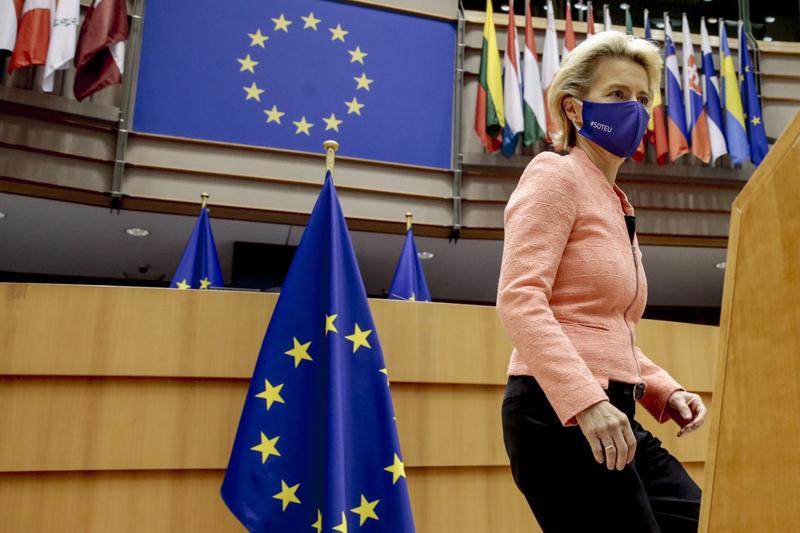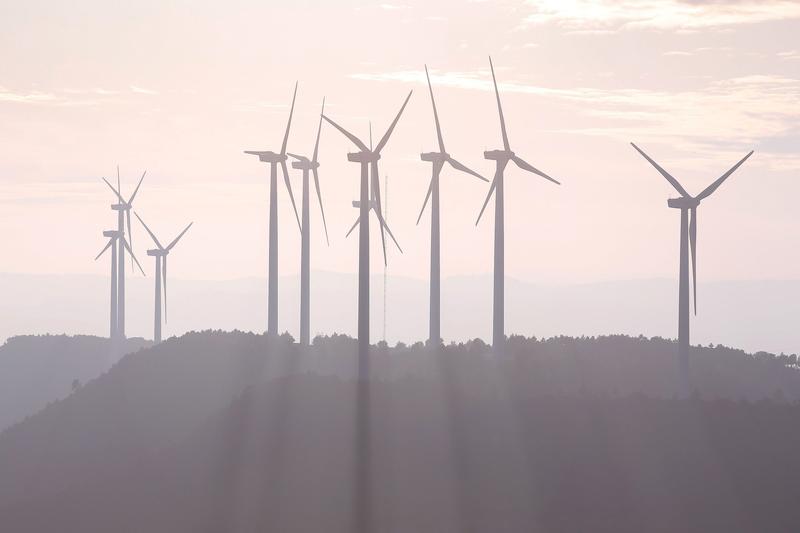 European Commission President Ursula von der Leyen arrives at the plenary ahead of her first State of the Union speech at the European Parliament in Brussels, Sept 16, 2020. (OLIVIER HOSLET / POOL VIA AP)
European Commission President Ursula von der Leyen arrives at the plenary ahead of her first State of the Union speech at the European Parliament in Brussels, Sept 16, 2020. (OLIVIER HOSLET / POOL VIA AP)
The European Union’s executive proposed toughening the bloc’s targets for fighting climate change in a move to cut industrial pollution and spur a green economic recovery.
I recognize that this increase from 40 percent to 55 percent is too much for some, and not enough for others. But our impact assessment clearly shows that our economy and industry can manage this.
Ursula von der Leyen, European Commission president
The 27-nation EU should tighten its emissions-cutting goal to at least 55 percent by 2030, European Commission President Ursula von der Leyen said on Wednesday. The current objective, agreed just six years ago, is a cut of 40 percent from 1990 levels.
The commission president also announced that the EU would sell 225 billion euros (US$267 billion) of green bonds as part of its 750 billion-euro pandemic recovery fund, which will be equivalent to roughly all the green securities sold globally last year.
“I recognize that this increase from 40 percent to 55 percent is too much for some, and not enough for others,” von der Leyen told the European Parliament in Brussels during her first state-of-the-union speech. “But our impact assessment clearly shows that our economy and industry can manage this.”
ALSO READ: EU chief unveils blueprint to get Europe back on its feet
Von der Leyen has spent 10 months in crisis-management mode as a result of the coronavirus pandemic while pressing ahead with plans for a green overhaul of the European economy, a digital-investment drive and more global free trade.
The pandemic has handed the 61-year-old von der Leyen a chance to accelerate her plans to make her European Green Deal the engine of economic recovery as governments mobilize unprecedented amounts of public money for the rebuilding effort.

The EU has taken a good step in the right direction. A 55 percent target will send a clear signal to market players on the solidity of the EU climate trajectory.
Simone Tagliapietra, researcher at the Bruegel think-tank
Under the new climate target for 2030, European automakers would need to adopt tougher pollution standards with new rules that could see combustion engines phased out completely. Energy will grow increasingly cleaner, with an additional 350 billion euros per year required for investment in production and infrastructure, according to a draft document seen by Bloomberg News.
READ MORE: End of combustion engine moves closer with EU climate plan
“The EU has taken a good step in the right direction,” said Simone Tagliapietra, researcher at the Brussels-based Bruegel think-tank. “A 55 percent target will send a clear signal to market players on the solidity of the EU climate trajectory. This is key to shape expectations and influence companies’ investment decisions and consumers’ choices.”
 In this undated file photo, Serra de Rubio wind farm's wind turbines are pictured in Castellfollit del Boix, Spain. (PAU BARRENA/AFP/GETTY IMAGES)
In this undated file photo, Serra de Rubio wind farm's wind turbines are pictured in Castellfollit del Boix, Spain. (PAU BARRENA/AFP/GETTY IMAGES)
A more ambitious climate target for 2030 is likely to garner broad support from member states and the European Parliament, whose approval is needed for the measure to become binding. Yet negotiations over the final shape of a deal are set to be fraught amid national differences in wealth, energy sources and industrial strength.
ALSO READ: Bust-up over climate weighs on EU-UK talks, risks trade rifts
The new goal will require buildings to become more energy-efficient and companies will face more strict pollution caps in the EU’s carbon market, the world’s biggest.
The proposal is an addition to a key climate law that will be the legal foundation of the European Green Deal, a sweeping strategy for Europe to zero-out greenhouse gases by 2050.


